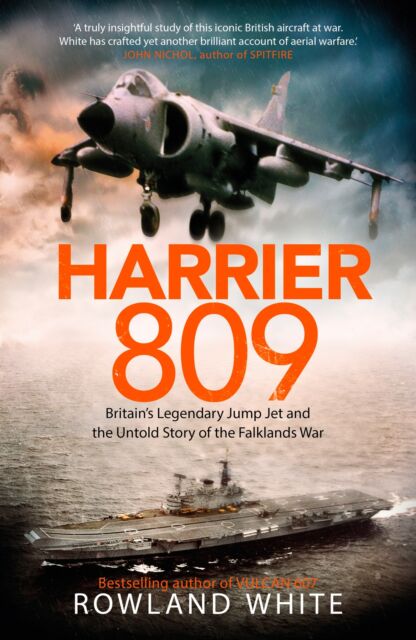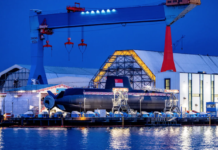
Harrier 809. Britain’s Legendary Jump Jet and the Untold Story of the Falklands War. By Rowland White. Bantam Press, an imprint of Transworld Publishers. ISBN 978-1-787-63158-8
Reviewed by David Hobbs
The overwhelming impression I gained from this book was one of disappointment. I didn’t even like its title, Harrier 809, since this naval air squadron was equipped with Sea Harriers, not Harriers, an important distinction given the effort that the Royal Navy had devoted to the design and procurement of this important aircraft.
It excelled in roles no other aircraft could have undertaken in 1982. The author seems not to have made up his mind whether to focus on 809 NAS or to write a wider history of the South Atlantic War. Unfortunately he uses a sensationalist style which trivialises the work of countless people who planned and worked so hard to make things happen, not least the commissioning of new naval air squadrons with newly-built aircraft and others held in reserve for just such an emergency.
My doubts became certainties as I read my way into the book and found that the author had little understanding of how the Royal Navy’s Fleet Air Arm was organised and administered, especially from a technical viewpoint, in 1982. This often leads to the personal reminiscences, which should have made such a valuable contribution to the text, appearing out of context and difficult to reconcile with recorded events.
There are some howling errors. Typical of these is the statement on page 21 that HMS Hermes was built by Harland & Wolff in Belfast. She was actually built by Vickers at their Barrow-in-Furness shipyard as Admiralty Job Number J 3295, Contractor’s Yard Number 928. If the author could not get a basic fact like this right, how many other mistakes are there in the 431 pages of text? I found myself having to double-check statements so frequently that I finally gave up. The statement on the dust jacket that this is ‘a truly insightful study of this iconic British aircraft at war’ is not supported by the text.
Attempts to portray the wider picture include a description on page 32 of UK concerns over a possible aircraft carrier sale to Argentina in 1967. The author fails to mention, however, that the light fleet carrier Warrior had been sold to Argentina in July 1958 and re-named Independencia.
An extensive package of training for her aircrew and ship’s company in carrier operations was provided by the Royal Navy. Her eventual replacement, formerly HMS Venerable/ HNethMS Karel Doorman was a modernised sister-ship. His brief history of 809 NAS on page 36 fails to mention deployments in HM Ships Unicorn in 1943 and Attacker in 1944. These are just a few examples.
A sensationalised description at the beginning of chapter three portrays an air engineering officer ringing Lieutenant Commander Gedge in his Third Flotilla office from a payphone in Southampton ‘shoving ten pence pieces into the slot’ until he ran out. Surely he had a name and, if a personal anecdote is worth including, his part in the overall scheme of things deserves description. It took place ‘on Saturday morning’ and I have no doubt Gedge did receive just such a telephone call but the date and context should be explained much more carefully.
The un-named officer was apparently seeking advice about how to build two flight decks on to the P & O liner Canberra and needed a pilot’s input and the tale ends with the statement that ‘Gedge wasn’t the only one winging it’. This is hardly just to the men who had created carefully-considered plans over the years to requisition and modify merchant ships for a variety of roles in the event of just such an emergency, implementing the lessons learned when the British Pacific Fleet was created in 1944/45.
Contingency plans had also been prepared to create new naval air squadrons which led quickly to the commissioning of 809, 825, 847 and 848 NAS and the significant expansion of others such as 829 NAS. The Director General Aircraft (Navy), DGA (N), was responsible for the provision of aircraft, advice on flight deck designs for shipping taken up from trade, STUFT, and the completion of aviation facilities as quickly as possible on new warships such as the carrier Illustrious. The Naval Air Technical Evaluation Centre, NATEC, played a critical part as did the RN aircraft repair organisation and many other directorates. Officers from all these were closely involved with Canberra and more than fifty other STUFT, any suggestion that they were simply ‘winging it’ is insulting to their achievements.
To put that telephone call into its proper context it must be understood that Canberra‘s conversion into a troopship was one of the first, and largest, undertaken. The decision to requisition her was taken on Saturday 3 April while she was still at sea and by Monday 5 April Vosper Ship Repairers had completed the necessary drawings for her flight decks and other changes with considerable input from experts in DG Ships, DGA (N) and NATEC; they had been approved by Stephen Hunter the Principal Naval Overseer and steel had been ordered.
Fabrication work started before the ship arrived in Southampton on Wednesday 7 April and during the next two and a half days two flight decks were installed together with RN communications equipment and replenishment at sea, RAS, arrangements. Naval construction expert David K Brown has written that Vosper personnel put in over 500 man-weeks of work in that time with experts from every relevant MOD (Navy) department on site working with them around the clock. The flight decks weighed 150 tons each and this top weight was partially offset by placing them over the swimming pools which had formally contained 95 tons of water. I know this work was not central to the commissioning of 809 NAS but, since the author has chosen to mention it as part of his wider story, it should have been described accurately if the story of the coin-box telephone call was to be understood in its proper context.
I could go on but I suspect that by now you will have appreciated just how disappointing I found this book to be. This is a pity because it could have been so much better, especially if the individual stories had been woven into a better factual and less sensationalist background. There are many better general accounts of the South Atlantic War of 1982 that are not limited by errors and a lack of research. The people who commissioned 809 NAS deserve their story to be told in a more accurate and better researched text; I cannot recommend Harrier 809.


